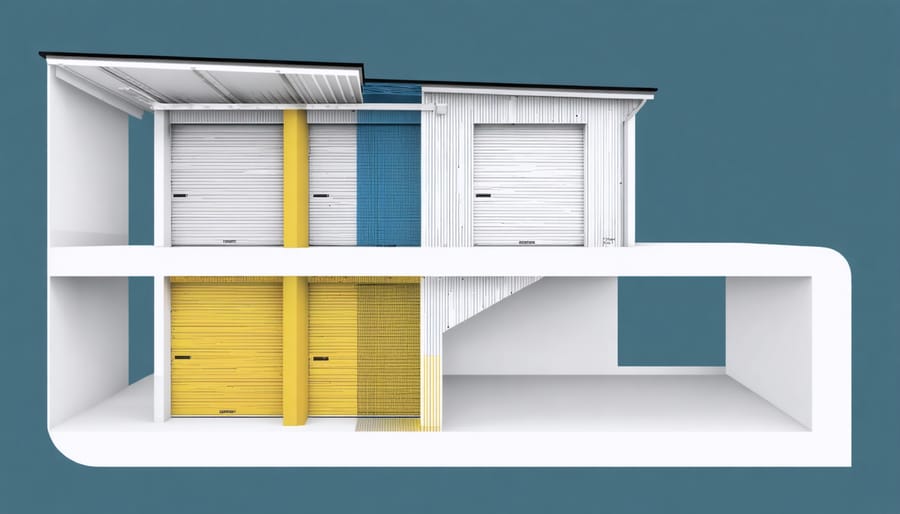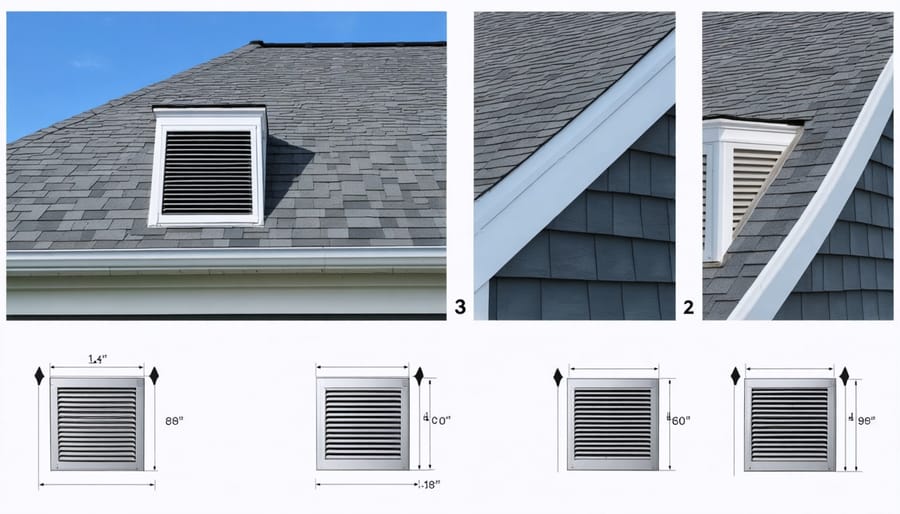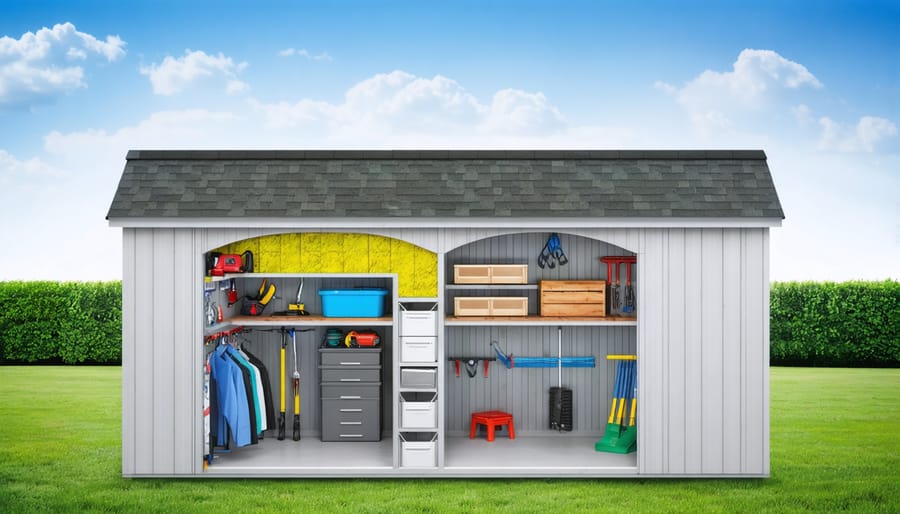Proper ventilation transforms a basic storage building into a lasting, protective haven for your valuable belongings. Whether combating moisture damage, preventing mold growth, or regulating temperature extremes, strategic vent placement stands as your first line of defense against environmental threats. Storage building vents work tirelessly behind the scenes, creating essential airflow patterns that protect everything from power tools to family heirlooms. Beyond basic function, modern vent designs complement your building’s aesthetic while delivering superior performance through innovative features like adjustable louvers and weather-resistant materials. For both new construction and retrofit projects, understanding your ventilation options ensures your storage space remains dry, clean, and properly preserved for years to come.
Why Your Storage Building Needs Proper Ventilation
Moisture Control and Mold Prevention
Proper ventilation plays a crucial role in controlling moisture levels within your storage building, protecting your valuable belongings from damage. When warm, humid air becomes trapped inside your shed, it creates the perfect environment for mold growth and can prevent tools from rusting and other metal items from corroding. Strategic vent placement creates a natural airflow pattern that helps regulate temperature and humidity levels throughout the year.
During warmer months, vents allow hot air to escape through the roof or upper walls while drawing in cooler air from lower vents. This circulation helps maintain a drier environment, reducing condensation that often forms when warm air meets cooler surfaces. In winter, proper ventilation continues to work by removing trapped moisture that could otherwise freeze and cause structural damage.
By maintaining consistent airflow, your stored items remain protected from musty odors, fabric deterioration, and costly moisture-related repairs.

Temperature Regulation
Proper ventilation plays a crucial role in maintaining comfortable temperatures inside your storage building throughout the year. During summer months, vents help release hot air that accumulates near the roof, preventing your shed from becoming a makeshift sauna. This natural airflow can keep temperatures up to 15 degrees cooler than in unvented structures.
In winter, vents continue their important work by managing moisture levels and preventing dramatic temperature swings. When warm air meets cold surfaces in an unvented building, condensation forms, which can lead to mold growth and damage to stored items. A well-ventilated storage building allows this moisture to escape while maintaining a more stable internal temperature.
Strategic vent placement creates a chimney effect, where cool air enters through lower vents while warm air exits through upper vents. This continuous air movement helps protect your stored belongings from temperature-related damage and extends the life of your storage building’s structure.

Types of Storage Building Vents
Ridge Vents
Ridge vents run along the peak of your storage building’s roof, providing continuous ventilation that’s both effective and visually appealing. These long, narrow openings allow hot air to escape naturally through the highest point of your structure while drawing in fresh air through lower vents. Unlike individual roof vents, ridge vents offer consistent airflow across the entire length of your building, helping maintain optimal temperature and humidity levels year-round.
Many homeowners prefer ridge vents because they’re practically invisible from ground level and complement most architectural styles. They work with your building’s natural airflow patterns, creating a reliable passive ventilation system that doesn’t require electricity or maintenance. During summer months, ridge vents can significantly reduce heat buildup, while in winter, they help prevent moisture accumulation that could lead to mold or rot.
Gable Vents
Gable vents are one of the most popular and effective ventilation solutions for storage buildings. Typically installed at the peaks of your building’s gable ends, these vents create a natural airflow system that helps regulate temperature and moisture. They work by allowing hot air to escape through the top while drawing in cooler air from below, creating a continuous circulation pattern.
Installing gable vents is relatively straightforward for DIY enthusiasts. You’ll need to cut an appropriately sized hole in your gable wall, frame it properly, and secure the vent with weatherproof flashing and caulk. Most home improvement stores carry pre-made gable vents in various sizes and styles, from simple aluminum designs to decorative options that can enhance your building’s appearance.
For optimal performance, consider installing a pair of gable vents on opposite ends of your storage building. This creates a cross-ventilation effect that maximizes airflow and efficiency.
Soffit Vents
Soffit vents are a popular choice for storage building ventilation, providing a sleek and effective solution along the eaves of your structure. These continuous vents allow fresh air to enter from the building’s lower portions while working in harmony with ridge or roof vents. Most soffit vents come in either aluminum or vinyl, with options for both continuous and individual vent designs. The continuous style offers a clean, uniform look, while individual vents can be spaced according to your needs. For optimal airflow, install soffit vents every 4-6 feet along your storage building’s eaves. Many homeowners appreciate that these vents are barely noticeable from ground level, maintaining their building’s aesthetics while ensuring proper ventilation. Remember to keep soffit vents clear of insulation and debris to maintain their effectiveness throughout the year.
Turbine Vents
Turbine vents, also known as whirlybirds, are dynamic ventilation solutions that harness the power of wind to keep your storage building well-ventilated. These rotating vents create a continuous air current, pulling hot, stale air out of your structure while allowing fresh air to flow in from below. What makes turbine vents particularly effective is their ability to work without electricity – the wind does all the work!
Many homeowners love turbine vents because they’re virtually maintenance-free and operate silently. Even on calm days, the heat rising from your storage building can cause the turbine to spin, ensuring consistent ventilation. These vents are especially effective in regions with regular wind patterns and can significantly reduce moisture buildup and heat accumulation in your storage space.
Best of all, turbine vents come in various sizes and finishes to match your building’s aesthetic while providing superior ventilation performance.
Calculating Your Shed’s Ventilation Needs
Calculating the right amount of ventilation for your storage building doesn’t have to be complicated. A general rule of thumb is to have 1 square foot of ventilation space for every 150 square feet of floor space. For most backyard sheds, this means you’ll need between 2 to 4 square feet of total vent space.
To determine your specific needs, start by measuring your shed’s floor space. Multiply the length by the width to get the total square footage. Then, divide this number by 150 to find your minimum ventilation requirement. For example, a 10′ x 12′ shed has 120 square feet of floor space, requiring about 0.8 square feet (or roughly 115 square inches) of ventilation.
Consider your climate when fine-tuning these calculations. Hot, humid regions benefit from additional ventilation – aim for 1 square foot per 100 square feet of floor space. In cooler climates, the standard ratio works well.
Remember to distribute your vents evenly for optimal airflow. A combination of low and high vents creates natural air circulation through the stack effect. Place intake vents near the floor on one side and exhaust vents near the roof on the opposite side. This arrangement helps maintain consistent airflow and reduces moisture buildup.
For added precision, factor in what you’ll be storing. Items sensitive to moisture or temperature fluctuations may require additional ventilation beyond the basic calculations.
Installation Tips and Best Practices
Tools and Materials Needed
To properly install storage building vents, you’ll need these essential tools and materials:
Basic Tools:
– Drill with appropriate bits
– Jigsaw or reciprocating saw
– Measuring tape
– Pencil
– Utility knife
– Screwdriver set
– Safety glasses
– Work gloves
– Dust mask
Installation Materials:
– Storage building vents (appropriate size for your space)
– Mounting screws
– Exterior-grade caulk
– Weather stripping
– Screen mesh (to prevent pest entry)
– Flashing (if installing roof vents)
– Construction adhesive
Optional but Helpful:
– Level
– Marking template
– Wire snips (for screen mesh)
– Paint (to match building exterior)
– Drop cloth
– Putty knife
Remember to check your vent manufacturer’s instructions, as specific models might require additional tools or materials not listed here.
Step-by-Step Installation Process
Installing storage building vents is a straightforward process that can significantly improve your shed’s longevity as part of your shed maintenance best practices. Start by marking your vent locations, typically placing soffit vents near the roof line and gable vents on the end walls. For soffit vents, cut the opening using a jigsaw, making sure it’s slightly smaller than the vent frame. Clean the area and apply weatherproof caulk around the opening’s perimeter.
Insert the vent, ensuring it’s level, and secure it with weather-resistant screws. For gable vents, create a cardboard template first, trace the outline, and cut carefully. Install a mounting frame if provided, then place the vent and secure it firmly. Remember to seal all edges with silicone caulk to prevent water infiltration.
For ridge vents, start at one end of the roof peak, remove existing cap shingles, and install the vent sections consecutively. Finish by adding new cap shingles over the ridge vent. Always double-check that your cuts are precise and the vents are properly aligned before final installation.

Proper ventilation in your storage building is not just an optional add-on – it’s essential for protecting your belongings and maintaining the structure’s integrity. By implementing the right combination of vents, you’ll create a balanced airflow system that controls moisture, prevents mold growth, and regulates temperature year-round. Remember to assess your specific needs based on your climate, building size, and stored items before choosing your ventilation solution. Whether you opt for ridge vents, soffit vents, gable vents, or a combination of these, ensuring proper installation is key to their effectiveness. Don’t hesitate to consult with professionals if you’re unsure about placement or installation techniques. With the right ventilation strategy in place, you’ll enjoy a well-maintained storage space that keeps your possessions safe and secure for years to come. Take action today to protect your investment – your future self will thank you for it.





Leave a Reply